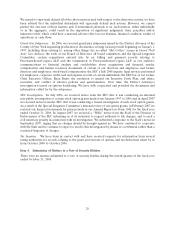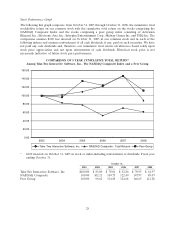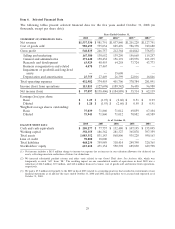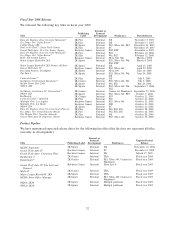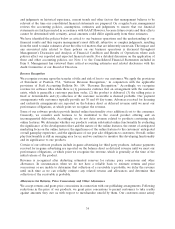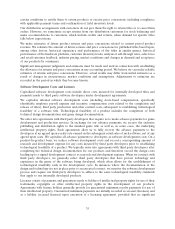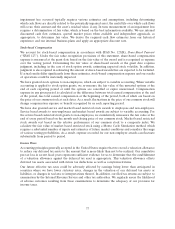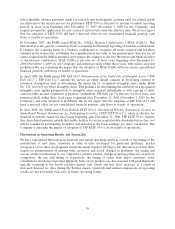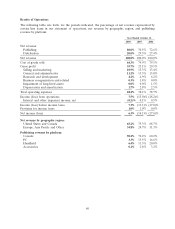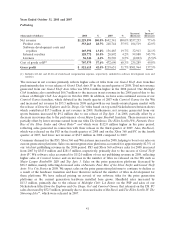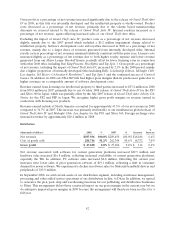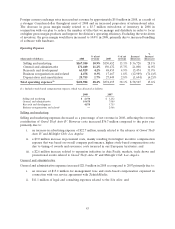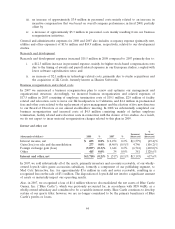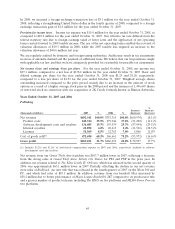2K Sports 2008 Annual Report Download - page 46
Download and view the complete annual report
Please find page 46 of the 2008 2K Sports annual report below. You can navigate through the pages in the report by either clicking on the pages listed below, or by using the keyword search tool below to find specific information within the annual report.performance remains to be completed by the licensor. When significant performance remains to be
completed by the licensor, we record payments when actually paid.
Certain licenses, especially those related to our sports products, extend over multi-year periods and
encompass multiple game titles. In addition to guaranteed minimum payments, these licenses frequently
contain provisions that could require us to pay royalties to the license holder based on pre-agreed unit
sales thresholds.
Amortization of capitalized software development costs and licenses commences when a product is
released and is recorded on a title-by-title basis in cost of goods sold. For capitalized software development
costs amortization is calculated using (1) the proportion of current year revenues to the total revenues
expected to be recorded over the life of the title or (2) the straight-line method over the remaining
estimated useful life of the title, whichever is greater. For capitalized licenses, amortization is calculated as
a ratio of (1) current period revenues to the total revenues expected to be recorded over the remaining life
of the title or (2) the contractual royalty rate based on actual net product sales as defined in the licensing
agreement, whichever is greater.
At each balance sheet date, or earlier if an indicator of impairment exists, we evaluate the recoverability of
capitalized software costs, licenses and any other unrecognized minimum commitments that have not been
paid, using an undiscounted future cash flow analysis. We use various measures to evaluate expected
product performance and estimate future revenues for our software titles including historical performance
of comparable titles; orders for titles prior to release; and the estimated performance of a sequel title
based on the performance of the title on which the sequel is based. When management determines that the
value of a title is unlikely to be recovered by product sales, capitalized costs are charged to cost of goods
sold in the period in which such determination is made.
We have established internal royalty programs that allow that certain of our employees participate in the
success of software titles that they assist in developing. Royalties earned by employees under this program
are recorded as cost of goods sold as they are incurred.
Asset Impairment
Business Combinations—Goodwill and Intangible Assets. The purchase method of accounting requires
that assets acquired and liabilities assumed be recorded at their fair values on the date of a business
acquisition. Our consolidated financial statements and results of operations reflect an acquired business
from the completion date of an acquisition. The costs to acquire a business, including transaction,
integration and restructuring costs, are allocated to the fair value of net assets acquired upon acquisition.
Any excess of the purchase price over the estimated fair values of the net tangible and intangible assets
acquired is recorded as goodwill.
We evaluate our goodwill annually for impairment or more frequently if indicators of potential impairment
exist. The determination of whether or not goodwill has become impaired involves a significant level of
judgment in the assumptions underlying the approach used to determine the value of our reporting units.
We generally use either the income, cost or market approach to aid in our conclusions of such fair values
and asset lives. The income approach presumes that the value of an asset can be estimated by the net
economic benefit to be received over the life of the asset, discounted to present value. The cost approach
presumes that an investor would pay no more for an asset than its replacement or reproduction cost. The
market approach estimates value based on what other participants in the market have paid for reasonably
similar assets. Although each valuation approach is considered in valuing the assets acquired, the approach
ultimately selected is based on the characteristics of the asset and the availability of information. Changes
in our strategy and/or market conditions could significantly impact these judgments and require reductions
to recorded intangible asset balances.
Long-lived assets. We review long-lived assets for impairment whenever events or changes in
circumstances indicate that the related carrying amounts may not be recoverable. Determining whether
36


